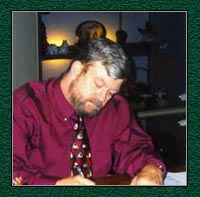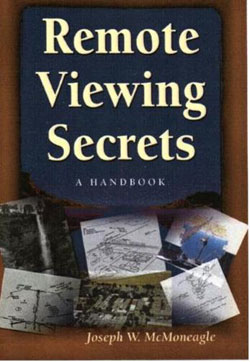
Joe McMoneagle
is considered to be the best remote viewer to come out of the US Army program
at Ft.
Meade. He was viewer
#001 in the unit and whenever the time came to impress members of the Senate
Intelligence Committee
about the capabilities of remote viewing it was usually Joe who was called
on to put
on the dog and pony
show.
Joe continues to put on demonstrations
of remote viewing, in real time, on camera and in front of audiences
worldwide. He has been "put to the
test" 17 times in front of television cameras. Recently he was in Japan
where
he did two televised remote viewing
demonstrations for NHK, a major television station in Tokyo. The show
was called "Battle TV."
 On
the program with Joe was a highly respected and extremely skeptical professor
of physics from the University of Tokyo. The professor boasted that he
would describe the "trick" used to give the illusion of remote viewing,
or else he would resign his position at the university.
On
the program with Joe was a highly respected and extremely skeptical professor
of physics from the University of Tokyo. The professor boasted that he
would describe the "trick" used to give the illusion of remote viewing,
or else he would resign his position at the university.
The professor himself selected the
first target.
Then, on camera in front of millions
of viewers McMoneagle drew a descending ramp beside a large concrete support.
The target was a circular ramp leading from a bridge.
In Joe’s words, "I pretty much nailed
it."
The professor protested (even though
he selected the target) that there are ramps like that all over Tokyo,
and complained that Joe could have simply guessed the target. Joe politely
countered that there are also temples and bowling alleys all over Tokyo
but he didn’t "guess" any of those.
So they had him work another target,
this time double-blind. This target was what is known in remote viewing
as a "beacon target," meaning
a person physically went to a location in real time, and Joe was to describe
that
location.
A woman was selected from the audience
to act as the "beacon." She was given a ticket on the bullet train
and
allowed three hours to go to any
location. Joe went to the television station’s "green room" and took a
2 hour
nap. (jet lag, or cooldown?) No
one in the studio (including Joe) knew where the woman was going.
The target turned out to be an artificial
pond used as an in-door hot bath. The studio audience judged
McMoneagle’s remote viewing data
to be 90 to 95% accurate.
As Joe left Japan the professor was
busy going over the tapes of the program trying to discover the "trick"
employed by Joe to so accurately
describe both targets.
No word yet on whether the professor
has indeed resigned from the university.
McMoneagle doesn’t do any formal
teaching these days, although he does give seminars from time to time.
For those who would like to learn
from Joe, he says his book "Remote Viewing Secrets" is a good place to
start.
Joe tells us, "I provide all the
materials and knowledge necessary to understand and set up one's own training
scenario
within my book."
"Aside from knowing what's in that
book and practice," says Joe, "there really is no way to train someone
to be a
remote viewer. At least that is
my belief at this time. This is also supported by science."
 What
about all the remote viewing courses being offered by other Ft. Meade alumni?
What
about all the remote viewing courses being offered by other Ft. Meade alumni?
"You should remember," says
Joe "that even those remote viewers who were in the Stargate Project,
and who say they can train people quickly, learned to do their own remote
viewing by doing two or more remote viewings a day, five days a week, in
excess of 12 months."
So his advice? Joe says, "I
guess the real name of the game is; practice, practice,practice, then when
you are exhausted from it, go back and practice some more."
McMoneagle does just that. He tells
us he currently does two or three targets a day. He works for private companies,
corporations, and even individuals. And when he’s not doing work for a
client Joe practices. "You have to use it or lose it," he says.
Many remote viewers believe that
they have to produce complex work each time they remote view. They strive
for the most specific, extremely detailed data on every target. You might
be surprised to learn that Joe McMoneagle feels low level data is best.
He says, "it is far better to be very good at describing an overall gestalt
for a target, and being able to do so every time you remote view- this
is called good replication- than it is to be able to do a perfect world-class
remote viewing now and then. Dependability and replicability is far more
desired than details."
McMoneagle is currently working on
his fourth book, which is due to be delivered to his publisher by the end
of February. Look for the book to be out in the fall of 2001. Joe is also
floating several screen plays in Los Angeles, one of which is about remote
viewing. And he would like to someday publish his novel "Pulling The Plug,"
written in 1991 about the Vietnam War.
Joe was scheduled to give a paper
at a technical conventional called "Tech Fest" in Bombay, India in early
February.
But he had a prior commitment to
a paying customer, so Joe won’t be going to India. His colleague
Dr. Edwin May
will present the paper in Joe’s
absence. There will be nearly 8 thousand engineers and scientists from
Asia at the conference,
and the paper done by McMoneagle
and May will be the only one dealing with the "paranormal."
Meanwhile McMoneagle continues to
do research into remote viewing. He is a full time research associate with
the original
lab that started it all back at
SRI-International. They have some new research projects planned for 2001,
which will take place
in a number of different countries.
The Hawaii Remote Viewers’ Guild
hopes to host Joe McMoneagle in the islands sometime in the new year.
 On
the program with Joe was a highly respected and extremely skeptical professor
of physics from the University of Tokyo. The professor boasted that he
would describe the "trick" used to give the illusion of remote viewing,
or else he would resign his position at the university.
On
the program with Joe was a highly respected and extremely skeptical professor
of physics from the University of Tokyo. The professor boasted that he
would describe the "trick" used to give the illusion of remote viewing,
or else he would resign his position at the university.
 What
about all the remote viewing courses being offered by other Ft. Meade alumni?
What
about all the remote viewing courses being offered by other Ft. Meade alumni?